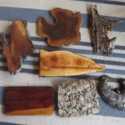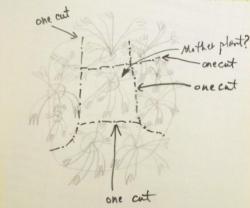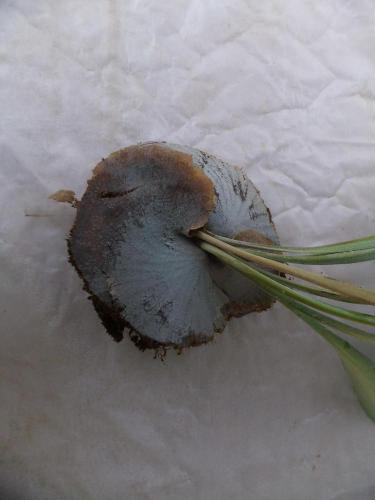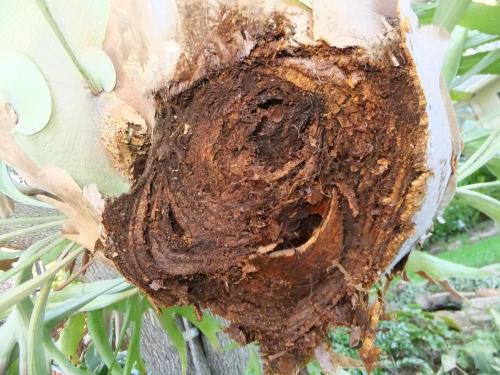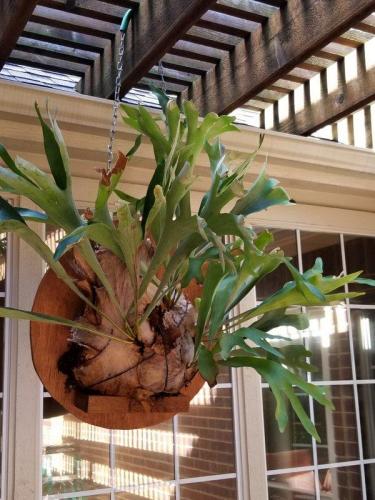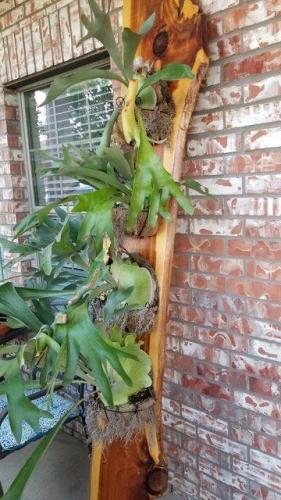
I wish I had pictures of the monster I HAD to divide and how I did it. It was over 100 lbs. and like yours, I had a block-and-tackle system for hoisting in in a tree. I will do my best to describe that division process.
The first thing I did was lower it to the ground, with the mount side down. Mine was growing on a large piece of marine plywood, something used in boat-building and readily available since I lived on the MS Gulf coast. Thus, since I was using a solid piece of wood, all the growth was directed in a 180 degree pattern. IF yours has growth in a wider pattern (growth behind as well as in front), you would want to carefully lean your mount against a firm surface (perhaps a brick wall or similar). That's a little bit trickier.
Your plant will be layer upon layer of basal fronds, and other than the top, green, basal fronds, the others will be brown, dry, and fibrous. I picked out the "pups" that were outmost from the "mother" plant to divide first. I used a large, 14-16" heavy-bladed, serrated kitchen knife to do the "surgery". I needed a blade that could "saw through those tough, fibrous fronds. You will have to use your judgment on how large a division you want to take. You just want to be sure that you leave that bright green basal frond intact (if there is a green basal frond). Also, you want to have at least 4 "reproductive" fronds on that division. Let's say you take a 12"x12" division. Most of that will be the brown, non-viable basal fronds. Just use that knife to "saw" the entire depth of fronds down to the mount. Heck, you may end up with a foot deep of brown basal fronds. That's what I had. When you have that 12x12 division cut out, just pry it away from the mount. Now you have a 12"x12"x12" division, and that's way too thick to mount. Using that handy-dandy knife, eliminate 9" of dead-frond thickness. You are thus "shaving" the division down (though cut it away in one chunk) so that it might now be 6" thick (counting the green basal frond, which is sometimes arched). Now you have a mountable-sized staghorn. I continued to do this around the whole periphery, gradually getting closer and closer to the "mother" plant. You can take every singe pup you want (remember the 4-frond minimum though). I think I ended up with 8-10 large divisions when I quit.
Another thing. If you have a whole side of pups (or the whole top or bottom of pups) and you'll be taking them all, just make a longer cut. You might then have several pups that total 12"w but 24" tall. Take the whole side, top, and/or bottom of pups and then cut it down as explained.
Don't throw away all that basal frond residue. It makes a great material to use to mount all kinds of epiphytic plants. It absorbs water and releases it slowly and basically won't rot. I had a garbage bag full of it and I still have that bag with the brown-frond material 20 years later! I have probably used 75% of what I started with.
Oh, when I had taken all those divisions and the "mother" plant was left, I pried her off the wood and then did the same thing with her stack of basal fronds that I did with the divisions. She was still a large plant but by reducing the brown basal frond layer, I reduced her weight by half. That thick layer of dead, brown basal fronds, particularly when they are soaked with water, is there the majority of the staghorn's weight is.
You asked about damaging roots. Staghorns, at least those mounted, won't have much root system. By removing that thick layer of basal fronds, you really won't do any damage to roots, but even if you did, it is unimportant. Staghorns use the roots for attachment but very little "feeding" activity. The basal and reproductive fronds are used for water/nutrient intake and transpiration.
I hope this makes some sense and helps you figure it all out.
